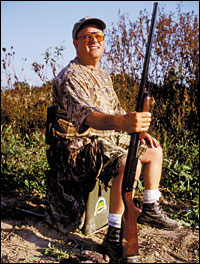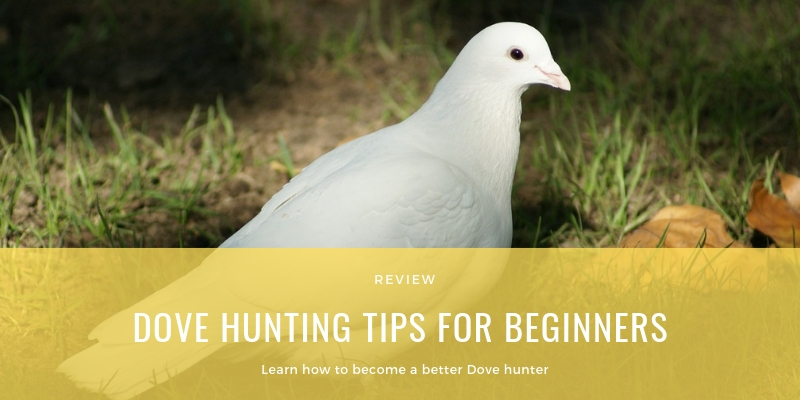The traditional September first dove opener is almost certainly the single biggest opening day in the United States. It’s also one of the single biggest days for shotshell manufacturers, with millions of rounds expended against these speed demons.
A dove’s small size, speed, and acrobatic flight all combine to make it one of wingshooting’s most difficult targets.
It’s said that one bird for five shells is a pretty good average. Usually, I can beat that, but add factors like a stiff breeze or birds that have already been shot at and one per five starts to look pretty good!

10 Tips For Better Dove Shooting
I just had a refresher course in missing doves in the grainfields of Sonora, Mexico. I was shooting with Alcamp (U.S. agent: Doug Mauldin, Derrydale Press, Lyon, Mississippi) near Hermosillo.
The doves were there in thousands, but so were extenuating circumstances: windy days and doves that had been shot at for months.
These were the most difficult doves I’ve shot at in years–and I won’t divulge my shell-to-bird ratio. But with Mexico’s higher bag limit and abundant birds, I did have a chance to relearn some old lessons.
Here are dove hunting tips for beginners:
1. Don’t be Overchoked
Due to their small size, doves are rarely as far as you think. Most shots are between 20 and 30 yards, and 40 yards is very, very far.
In most situations, you’ll drop far more birds with an Improved Cylinder or Skeet choke than with Modified or tighter. If your gun has interchangeable tubes, start with an open choke; you can always tighten up if the birds are flying high.
2. Use Good Shells
Generic “dove loads” are usually cheaper due to second-quality shots. A less uniform shot means poorer patterns, and doves are small enough to be very unforgiving of holes in your patterns.
Buy good dove shells. Target loads are a good choice; they’ll cost a bit more, but chances are you’ll shoot fewer in filling your limit. Number 8 shot is generally the best choice.
Read: Shotgun Patterning: Why Do Hunters Pattern Their Shotguns?
3. Choose Your Ground Carefully
Doves will normally fly along with definite terrain features; rarely do they enter or leave fields or go to water in a random fashion.
Treelines, fence lines, drainage ditches, even prominent individual trees, and shrubs are likely spots to take a stand.
Avoid spots surrounded by high vegetation where recovering downed birds would be difficult.
Don’t be too stubborn to move if it looks like birds are flying better down the line. But don’t crowd your neighbor–make certain you know exactly where any other shooters are, and make certain they know where you are.
4. Use Cover
Doves become wary as soon as the first shots sound. Pick your spot in some taller grass or weeds, so your silhouette is broken.
5. Mind Your Shooting Stance
If there’s enough cover so you can stand, all the better. Alternatively, bring a camp stool so you can sit comfortably and rise quickly if the cover is not enough.
If you have to hunker down on the ground, you won’t be in a comfortable position to shoot and you’ll lose some opportunities because it takes too long to stand up.
6. Don’t Commit Too Early
Under ideal circumstances, you can see doves coming a long way out. Stay still and let them come.
Pick your bird, then raise the gun, swing, and fire–all while the bird is in range. Raising the gun and tracking the birds too early invites unhittable acrobatics.
7. Stay Alert
It’s almost impossible to watch all directions, so pick the most likely direction for birds to fly and concentrate your attention there, understanding that you might miss out on the odd birds that do the unexpected.
Pay attention, swiveling your eyes back and forth across the horizon.
If more birds are surprising you by coming from behind, you may have missed the flight pattern, so don’t be reluctant to shift your focus.
8. Learn to Shoot Fast
On incoming birds, your best opportunity is to shoot them as they come in, with the shotgun at no more than a 44-degree angle to the ground.
Optimally, you should wait until the last moment, then raise the gun and fire as quickly as possible.
The ones that surprise you by coming from behind must be taken even more quickly; add in reaction time and such birds are out of range unless you can get on them fast.
9. Mount the Gun Properly
I find that my second most common error comes from simply raising the shotgun and firing, without properly seating the gun to my shoulder and getting my head down on the stock–especially on those birds that seem to come out of nowhere.
Concentrate on mounting the gun smoothly and getting your head down on the stock as your eyes and hands begin swinging with the bird.
10. Don’t Be Afraid to Lead
Everyone is most likely to miss by shooting behind the bird. How much lead depends on the distance, wind, and speed of the swing, so there are no absolutes.
But if you’re missing, chances are you’re either stopping your swing or not leading enough. Both mean you’ll shoot behind the bird.
On a windy day in Sonora, I found myself needing fully six feet of lead on crossing shots with the wind–and the birds weren’t all that far away!
My Experience
The scene of my first-ever dove hunt was one of those crowded fields where you have to root for a bird to get by everyone else so you can shoot it. The slow, the stupid, and the unwary fell from the sky long before they got to within 100 yards of the knoll where I sat, partially hidden under the branches of a tree.
The doves I shot at streaked by with their eyes and their throttles wide open. Up to that day, the only birds I had ever seen over a shotgun rib were ringneck pheasants clambering up and away over the cornfields. Nothing in my experience prepared me for the stream of tiny gray bullets zipping overhead.
Experts, of course, brag about shooting a limit of doves “inside a box,” taking 10, 12 or 15 birds with one box of shells or less. So it’s my duty to tell you that on that very first dove hunt, 25 years ago, I easily bagged my limit inside a box.
Unfortunately, it was one of those big boxes that hold 10 smaller 25-round boxes of shells.
There’s no question doves make one of the toughest targets in the sky. Ammo companies estimate hunters shoot five times for each bird they bag. I’ve improved my average a good deal since that first hunt years ago. You can too.
Becoming a better dove shot began, of course, earlier this summer, when you put in your time shooting skeet and sporting clays (you did, didn’t you?). Nevertheless, the transition from clay targets to real birds can be a rocky one come opening day.
Dove Hunting Shooting Tips
It’s not so much that doves are fast; in fact, serious clay target competitors tell me they often shoot in front of live birds after a summer of clay birds. The problem is, clay targets fly straight paths while doves juke all over the sky.
Clay target shooting sharpens your hand/eye coordination and builds solid shooting form, but it can make you a little complacent, too.
After a summer of target shooting, when you look at the dove and judge its line of flight, you assume it’s going to keep going in the same direction at the same speed. When the dove changes direction, it leaves your muzzle hanging in space, pointed yards away from where it needs to be.
What’s worse, many hunters treat smoothbores as if they were anti-aircraft weapons, mounting the gun, aiming down the rib, and tracking the bird as it comes into range.

The longer you track a dove and the more carefully you measure your lead, the greater the chance you’ll slow or stop your swing or that the bird will dodge out of harm’s way. Instead, think “eyes to the target, hands to the target”–in that order. Lock your eyes onto the dove as it comes to you, but don’t budge the gun until you’re ready to shoot.
Rather than leaping to your feet while the bird’s still a way out, it’s often best to wait until the dove is right on top of you before making a move.
As you mount the gun, your first move should be with the muzzle, sweeping it along the dove’s line of flight and holding slightly below the bird so you don’t obstruct your view of the target.
Raise the butt as the muzzle moves with the target, and shoot the instant the pad hits your shoulder. It’s a short, compact move.
On the close shots, you won’t be aware of leading the bird at all; you’ll be shooting as the barrel passes the beak. If your eyes remain locked firmly on the dove’s head, your hands and the gun will follow to the right place automatically even if the dove pulls a last-second evasive maneuver.
On shots that require short leads, simply flick your eyes ahead of it at the last second, and the gun will follow.
Pretend the bird has a dollar bill in its beak, and make that your target.
Doves crossing in the distance require a slightly different technique. Rather than swinging through the bird, insert the muzzle ahead of it. You still move the barrel along the bird’s flight line as you raise the gun, but your target becomes an invisible, moving spot two or three feet ahead of the dove.
Don’t try to measure the lead; just get the muzzle out in front of it, and good things will probably happen.
Shooting Overhead Doves
Overhead doves present a shot that looks much more difficult than it actually is, and it impresses bystanders when you pluck a bird from what seems to be the stratosphere.
A dove over your head appears much farther away than it actually is, just as the moon looks huge when it’s touching the horizon yet seems smaller and smaller as it climbs into the open night sky.

The overhead shot used to give me fits, until the day I was fortunate enough to find myself crouched behind a levee at the edge of Uruguayan cornfield. Spot-wing pigeons (think “doves on steroids”) flew over me in waves, and I’d hide behind the levee until they were right overhead, then stand to shoot.
From that afternoon on, the overhead shot has been my favorite.
Most of the time, birds that are overhead don’t require much forward allowance at all. Swing the gun fast along its line of flight, and when the bird disappears behind the muzzle, shoot.
Don’t peek around the barrel at it to measure lead. Just blot the bird out, pull the trigger and keep swinging.
Do it right, and you’ll be rewarded with a gasp of awe from the onlookers, and a bird that folds cleanly and takes forever, it seems, to fall to the ground.
Recovery Tactics
Make sure your eyes stay on that bird as it falls and hits the ground. Downed doves can be difficult to find, and there’s no point in shooting birds you can’t recover. Marking fallen birds is a dove hunting skill as essential as hitting them in the first place.
Watch the bird fall, and don’t take your eyes off the spot where you saw it auger in. Your eyes will fix on a particular weed or tall stem. Walk straight to it without ever looking away, and don’t even think of shooting at another bird until you’ve recovered the one you just shot.
Also, pay attention to where the birds killed by the shooters to your right and left fall. It’s much easier to find a dead dove if you have two separate fixes on its location and can triangulate.
While retrievers will find birds you cannot, get a good mark on the dove’s fall even if you have your dog along. Dogs don’t last long in the heat, and the rank greenery of late summer presents difficult scenting conditions for the keenest of noses.
The best dove hunt I was ever on took place in a field where the owner had planted scraggly strips of sunflowers spaced widely across bare, disked earth. When you dropped a dove, it fell to the ground with a little puff of dust. I don’t believe I lost a bird in two days of tremendous shooting.
Finally, recovering birds begins before you pull the trigger. If you don’t know where a bird will fall, or if you see that it will drop somewhere it will be difficult to find, don’t shoot. There will be another bird along in a minute.
Bonus Dove Hunting Tips and Tricks
Dove hunting may be more about shooting than hunting, but if you use a little field-craft to hide from birds, you’ll get easier opportunities. A dove that never knows you’re there is much, much easier to shoot than a bird making a wide detour around you. I would recommend you be attentive to the following bonus dove hunting and tactics.
Don’t silhouette yourself. Sit in the shadow of a tree, or kneel by a fenceline, or use a tall stand of corn or sunflowers to your back to break up your outline. Take a small portable blind or some camo netting to the field. Don’t stand until you’re ready to shoot.
Hide too well, though, and you can’t see the birds coming. On an Ohio dove hunt a few years ago, a friend and I sat in the shadow of a long strip of cut corn with the tall standing stalks at our backs for cover.
We were well hidden from the doves; the problem was when birds came in from behind us low over the tassels, we couldn’t see them until they flashed over our heads. Most of them were gone before we could react.
We left the standing corn, walked out into the middle of the cut strip, and laid on the ground in the stubble, facing in opposite directions. The birds scooting in low over the ground never knew we were there until we sat up to shoot.
It was like a field duck hunt in fast motion, with birds coming in at every conceivable angle and flaring wildly if we missed with our first shot. I don’t think I killed my limit inside a box that day, but there was no time to count shells, and I was having way too much fun to care.
Becoming a better dove shot is, of course, a highly commendable goal, but it shouldn’t become an end unto itself. Let the other hunters hoard their ammunition, cherry-picks the easy shots, and brag about how much fun they had not shot.
Dove hunting isn’t about bird-to-shell ratios, it’s a 21-gun salute to the promise of another fall. After all, who cares if it takes more than 25 shells to properly ring in the hunter’s New Year?
alloutprodux.com




